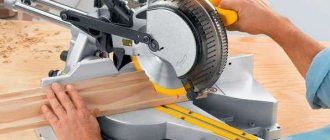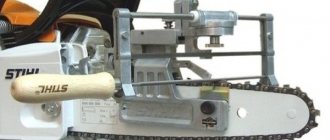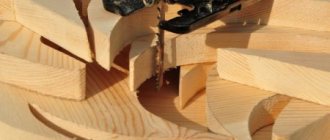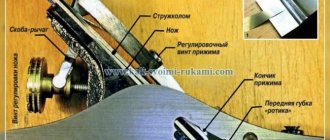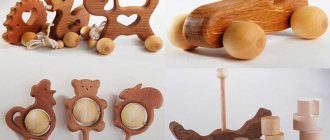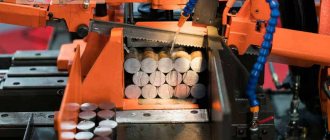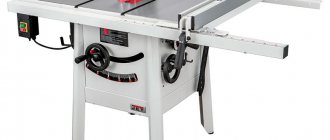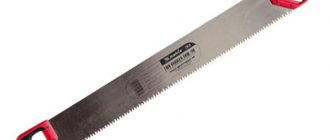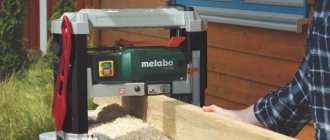A miter saw (“miter saw”) is an excellent assistant for a professional joiner, carpenter, finisher, and any home craftsman when performing repair and construction work. The models present on the domestic market differ significantly in their capabilities and cost, so the question of how to choose a miter saw for the home is quite relevant among consumers.
The most logical solution would be to seek help in resolving this issue from a sales consultant, but for a substantive conversation you must initially have an idea about the features of this tool.
Purpose of a miter saw
The very name “cross-cut” serves as an indication of the purpose of this saw - shaping the ends of the workpiece, cutting wood across the grain. In this it differs from its closest relative - the circular saw, which is used, as a rule, for longitudinal cutting of wood.
Modern powerful engines and especially durable saw blades allow the miter to cut not only wood, but also plastic, thin metal profiles and pipes, and wood-based composite materials. For these materials, the concepts of “longitudinal” and “transverse” are very arbitrary: if such terms are used, then we are not talking about the structure of the material, but about the shape of a specific workpiece. Of course, the shape of the workpiece can be very diverse, sometimes without a clearly defined longitudinal axis.
The applicability of a miter saw in a particular case is determined solely by the convenience of feeding a particular workpiece. Thus, the name “miter saw” cannot be considered to fully reflect the potential of this tool; it’s just that this name has historically been assigned to stationary circular saws with a movable cutting unit.
A miter saw can cut material not only at a straight line, but also at an arbitrary angle, for which it is sometimes called an electric miter box. Moreover, many modern devices allow changing the angle not only in the horizontal, but also in the vertical plane, i.e. it is capable of sawing at an angle. Using a miter saw, you can even select grooves if necessary.
As you can see, the capabilities of this tool are much wider than you might think at first. It is not surprising that crosscut saws can be found more and more often in small carpentry shops, on construction sites, and in home workshops. Their help is used in the manufacture of window frames and door frames, when laying floors (cutting parquet boards, laminate, baseboards) and other finishing work (cutting lining, various aluminum and plastic profiles), and in the manufacture of wooden furniture.
The structure and functionality of a miter saw
The trimming device is easy to understand from the figure, which shows the main components of the tool. Everything else is just additions that do not change the principle of operation, but only improve functionality and ease of use.
1 . Handle with power button. 2 . Saw blade. 3 . Protective cover. 4 . Clamp for securing the workpiece.
5 . Workpiece stops. 6 . Mechanism for fixing the table at a given angle. 7 . Horizontal angle adjustment scale. 8 . Table.
9 . Vertical angle adjustment mechanism. 10 . Dust collector. eleven . Engine. 12 . Carrying handle.
The main elements of a miter saw are an electric motor and a saw blade made of high-quality heavy-duty steel. The engine, saw blade and gearbox connecting them make up a functional unit, and a handle with a switch is located here.
The entire block is attached to the base - the bed, on which the workpiece to be cut is placed. A turntable, which moves when the cutting angle is set, and a stop are fixed to the base. The frames of relatively expensive devices are made of durable and lightweight aluminum or magnesium alloys, which ensures not only the reliability of the base, but also the mobility of the entire tool by reducing weight.
The functional unit is connected to the frame via a swing arm using a spring-loaded hinge. The rotating lever is called a pendulum, and the miter saws of this type themselves are called pendulum saws.
The pendulum ensures the movement of the working module. To make a cut, you need to lower the lever down, “drowning” the saw blade in a stationary workpiece (for unhindered sawing, there is a slot in the turntable of the bed). This is the simplest version of a miter saw. As a rule, all modern models are equipped with a mechanism that ensures rotation of the desktop, along with all mechanisms, in a horizontal plane.
Thus, the guides and table elements remain stationary, and the tool itself changes its position in the horizontal plane. The use of such a tool gives more possibilities for facing.
Combined-type saws have another hinge that allows you to rotate the lever relative to the vertical axis (that is, with such saws the cutting angle can be changed in two planes). Often rotation around a horizontal axis is allowed only in one direction - the opposite direction from the electric drive.
But there are models that allow you to tilt in both directions.
Such technical solutions greatly expand the list of tool functionality. Inclined cutting relative to the vertical allows you to trim workpieces whose height is greater than the active radius of the disk.
The cutting width of a miter saw is relatively small, especially when working at an angle or slope. For example, an average pendulum saw with a 10-inch blade will cut a 95x95 mm beam or a 69x135 mm board at a right angle (when setting any other angles, the permissible size of the workpiece is reduced). In other words, a miter saw is unsuitable not only for longitudinal cuts, but also for cross cuts of wide workpieces.
To increase the cutting width, the saw is equipped with a traction function. The working block of a trimmer with this function moves not only around the hinge axis, but also along the cutting line along guide rods, due to which the maximum cutting width at an angle of 90° increases from 80-180 mm to 280-340 mm. These tools are called broach miter saws or horizontal motion miter saws.
At the same time, the mechanisms that implement the movement of the saw along the workpiece vary depending on the manufacturer and model of the device.
Types and choice of engine for trimming
Most often, the miter saw motor is located to the right of the work blade. However, on some units it is moved back to maximize the view of the working surface (regardless of which hand the operator is working with) and not create obstacles when making an inclined cut - such saws, as a rule, have the working head tilted in both directions.
Two types of electric motors are installed on trimming machines - asynchronous and commutator.
Asynchronous motor
An asynchronous motor is considered more economical, reliable and silent. There are no contacts in it, which means there is nothing to make noise, overheat and fail under the influence of external factors - dust, humidity, vibration. Apart from the bearings, there is simply nothing to wear out there, so such units can serve without any complaints for decades.
However, not all manufacturers of power tools strive to equip their products with such seemingly ideal engines, since they have asynchronous motors and have their own significant drawback - low power with a fairly large weight.
For example, a 2-kilowatt engine of this type weighs more than 20 kilograms. Agree, it is quite difficult to manually move a working unit with such an additional weight. In addition, when powered by industrial frequency current, an asynchronous motor is, in principle, unable to reach a speed of more than 2850 rpm. Of course, the use of modern materials and powering the motor with high-frequency current to some extent eliminates these problems, but does not eliminate them completely.
Brushed motor
In terms of size and power ratio, brushed motors look much more attractive. With a comparable mass, the torque of a commutator motor is several times greater than that of an asynchronous motor. It is capable of delivering up to 5-10 thousand rpm, and the organization of the control system and speed stabilization is much simpler.
It is not surprising that despite the disadvantages of commutator motors (high noise level, the need for regular maintenance, which consists of replacing commutator brushes), most miter saws are equipped with them.
Brushless motor
However, there is another option, based on modern semiconductor technologies - the golden mean between asynchronous and commutator types of motor. We are talking about valve-type or brushless motors (marked with the letters BL from the English brushless). In valve motors, the brush-commutator assembly is replaced by an electronic unit, characterized by negligible resistance and enormous switching speed of electronic power valves.
Motors of this type combine all the advantages of asynchronous and commutator motors - high torque and efficiency, quiet operation, unpretentiousness to external factors, long service life, no need for regular maintenance. On modern high-quality miter saws, valve motors are increasingly being installed, because their only drawback - the high price - is more than compensated for by so many advantages.
Rules of care
In order for the trimmer to last as long as possible, you should follow the rules for servicing the device:
- After each use, thoroughly clean the cutter, receiver and table of chips.
- Make sure that the ventilation grille on the housing is not clogged with sawdust or dust.
- Periodically tighten bolts and nuts.
- Change the brushes on the commutator motor when they wear up to 5 mm.
- Avoid overheating or pulling on the power cord.
Do you need a miter saw for your job?
Not really
Types of gearboxes, their advantages and disadvantages
The connecting link between the electric motor and the saw blade is a gearbox that transmits and converts the engine torque. There are two types of gearboxes used on miter saws - gear or belt drive.
Gears, which provide a rigid connection of shafts, seem more reliable. They don't slip or fly off like a belt, and there's nothing to break there. It would seem that miter saw manufacturers should give preference to such a reliable system. However, in practice, belt drives are seen more often on these tools than gear drives.
What is the reason? Gear reliability has a downside. If an emergency situation occurs, the gear reducer may fail, and then it will require a complete replacement or serious repairs in a specialized service center, but you can also look at the belt drive with different eyes. Yes, sometimes the belt falls off or even breaks, but installing it in place or replacing it with a new one does not require special knowledge and skills - an ordinary user can handle this task. In addition, the belt provides some dampening of radial and axial vibrations, which helps reduce wear on bearings and other engine components.
In the event of an emergency overload of the tool (for example, when a saw blade jams), even a well-tensioned belt will slip, which will save the metal parts of the motor from destruction. And a saw with a belt drive produces incomparably less noise, which is also a fairly significant factor.
Miter saw with belt drive.
By the way, some manufacturers (including such reputable ones as Bosch and DeWalt) have completely eliminated the gear unit from a number of their models, installing the saw blade directly on the motor shaft. This solution also has its pros and cons. On the one hand, the load on the bearings increases, on the other, the noise emitted by the tool is reduced, the reliability of the design increases, and maintenance and repair are simplified.
Power and number of revolutions
The power of miter saws can vary depending on the model from 800 to 2500 watts. The golden mean is considered to be 1600–1800 W - tools of this power are most in demand today, because they do their job equally well both in home workshops and in small production.
What does knowing the value of such a parameter as power consumption give us? Firstly, the correct correlation between the power of the miter saw and the structure of the material being processed will avoid overloading the tool, which prolongs its active operation time.
Secondly, the greater the power of the saw, the larger the diameter of the disk that can be installed on it. As an example to support this statement, let's compare two miter saws from Bosch. For the PCM 7 model, whose power is 1100 W, you should select a disk with a diameter of no more than 190 mm. But for the GCM 10 J Professional with a power of 2000 W, a disk with a diameter of 254 mm is suitable. It should be borne in mind that as the power of the saw and the outer diameter of its disk increase, the dimensions and weight of the tool increase. So, the first of the models given as an example weighs 9 kg, and the second is already 14.5 kg.
Another technical characteristic that you should pay attention to when choosing a miter saw is the number of revolutions of the saw blade. The value of this parameter lies in the range from 3200 to 6000 rpm. A clean and high-quality cut (without chipping the coating, splitting off wood fibers, etc.) is only possible when working at high speeds.
So, for example, with a saw blade diameter of 260 mm, its angular speed must be at least 2800 rpm. In expensive professional models, the angular speed, as a rule, is not lower than 4000-5000 rpm. even with large disc diameters. A number of manufacturers offer miter saws, the number of revolutions of which can be adjusted depending on the type of work being performed at the moment.
Video description
Video review of the Makita LH1040 miter saw:
- Einhell TH-MS 2112. High-power saw made in China in the budget segment. Used for wooden workpieces. Operator safety during operation is ensured by a durable protective casing. The unit is well suited for comprehensive household work. The only drawback is the strong operating noise.
- STURM! MS5525S. A machine from a Russian manufacturer with the largest cutting length in its price category. A powerful 2 kW engine at 4.8 thousand rpm, equipped with a 25 cm disc, ensures fast and high-quality cutting of workpieces. The downside is that the swivel device is not very convenient.
On a note! The characteristics of the workpiece cut - quality, accuracy, speed - are largely influenced by the speed of the disk. For this reason, professional models have a high rotation speed - up to 6 thousand rpm.
Additional accessories
Almost all modern models of miter saws have some additional devices and functions aimed at making work easier and increasing safety. At the selection stage, the future user of the tool will have to figure out for himself which of them are really necessary to solve the typical tasks he faces, and which will be an unjustified waste of money.
1. The dust removal system consists of a pipe and a dust bag or a hose of an industrial vacuum cleaner connected to it. The second option is preferable because it allows you to more effectively capture fine dust of the material being processed, which is formed when performing a precise cut when the saw operates at high speeds and/or with disks with an increased number of teeth.
The dust extraction system should not be considered as an additional, optional feature, even if you are faced with the task of choosing a miter saw for your home, i.e. low-intensity occasional work on it is assumed. By working without a dust extraction system, you risk not only the safety of the equipment in the workshop (and primarily the saw itself), but also your own health.
2. The protective cover completely covers the working blade until it is immersed in the material being cut, which significantly reduces the risk of accidents when working with a miter saw.
3. Limiting the cutting depth is used to carry out work on cutting grooves or trimming profiles.
4. The laser “draws” a guide line on the workpiece in the place where the saw will make the cut. The presence of this option increases the cutting accuracy (especially when sawing at angles other than 90 degrees), facilitates the work, and reduces pre-preparation time.
5. Illumination of the work area can be useful when working in workshops or workshops with insufficient general lighting.
6. Soft start ensures a gradual increase in engine speed when turned on, which prevents the tool from “jerking” at start-up, reducing the risk of the saw failing due to a sharp jump in current and the likelihood of the equipment jamming at the beginning of work.
7. Automatic shutdown when the saw blade jams is another useful feature aimed at increasing safety when working with a miter saw.
8. Adjusting the number of revolutions allows you to vary the cutting speed. Most miter saw models do not have this feature. However, it allows you to better adjust the sawing process to the characteristics of the material being processed. Recommended for those who plan to work not only with wood, but with various wood-based materials, plastic, plexiglass, etc.
9. Maintain constant speed during load increases. With this function, the engine speed does not drop under heavy pressure, since the electronics make adjustments to the speed. The end result is a neat and clean cut.
Review of popular models
The most popular models, according to user reviews, in various price categories are summarized in the following table. The cost is given as of the second quarter of 2021, when selling the instrument through specialized retail chains.
trading networks.
| Model | Category | Average price (as of May 2021), rub. | Rating, according to our editors | Number of assessment points |
| "ZUBR ZPT-210-1400 L" | Budget models | 4 500 | 1 | 9,9/10 |
| "Caliber PTE-1200/210M" | 4 000 | 2 | 9,8/10 | |
| "Metabo KGS 216 M" | Middle class | 17 200 | 1 | 9,9/10 |
| "Bosch PCM 7" | 12 500 | 2 | 9,8/10 | |
| "Makita LH1040F" | Premium class | 28 000 | 1 | 9,9/10 |
| "Metabo KGS 315 Plus" | 55 000 | 2 | 9,8/10 |
Choosing a miter saw is a crucial moment for the inexperienced
Choosing a miter saw is a crucial moment for an inexperienced user, so reviews from experienced consumers and advice from experts will help make the right decision.
Saw blades
Often, novice craftsmen who do not have sufficient knowledge, but have a great desire to purchase a new tool, ask the question: “How to choose a miter saw for wood?” This question is not entirely correct. Any trimmer can handle cutting wood, because that’s what it was created for. But how much you like the result of the work depends not so much on the tool itself, but on the equipment installed on it - the saw blade.
1 . Technological slots. 2 . Landing diameter. 3 . Outside diameter.
4 . Outer diameter value. 5 . Maximum disk rotation speed. 6 . Disc for cross-cutting with 96 teeth.
7 . Disc thickness value. 8 . The value of the landing diameter.
Outer and landing diameter of the disk
The main parameters when choosing saw blades, which you should pay attention to first of all, are the dimensions of the outer and landing diameters. Most of the miter saws produced today are designed to work with discs whose seat diameter is 30 mm.
There are exceptions with deviations in both directions, but there are relatively few of them. The outer diameter of saw blades varies significantly more. The most popular are 10-inch and 12-inch standard wheels. It should be borne in mind that 12 inches can mean either 300 mm or 305 mm, and 10 inches can mean 250, 255 or even 260 mm, and discrepancies occur even among the same manufacturer. Disks of smaller (185-216 mm) and larger (up to 360 mm) diameters are less common, since less equipment corresponding to them is produced.
Increasing the diameter of the saw blade allows you to process workpieces with a larger cross-section, while increasing the productivity of the tool and the quality of the cut at the same speed. However, larger discs require higher torque, which means additional power reserves. However, it will not be possible to use saw blades whose outer diameter exceeds that specified in the tool’s passport: the design of the trimming device simply will not allow the installation of such equipment, which will protect particularly careless users from dangerous experiments.
It is possible to install a disk with a smaller diameter, but it is not recommended. This will lead not only to the loss of the effective radius and performance of the tool, but also to a decrease in the calculated dynamic resistance, as a result of which the engine, in the absence of stabilization of speed, may “go into overdrive.”
Safety at work
Miter Saw Angle Chart
A miter saw is a dangerous tool that requires compliance with safety regulations. A crosscutter is a power tool that is equipped with sharp cutting elements, so you must wear safety glasses to protect your eyes. To ensure the safety of the master, it is recommended to buy a device with a protective casing that fits over sharp elements.
Modern devices are often equipped with a special mechanism that automatically turns off the saw when the blade stops in the wood. Some devices have a soft start or auto-lock function. This is typical for Makita wood saws.
Many manufacturers additionally add a special electrodynamic brake system to their devices. They smoothly stop the engine after disconnecting from the power supply.
